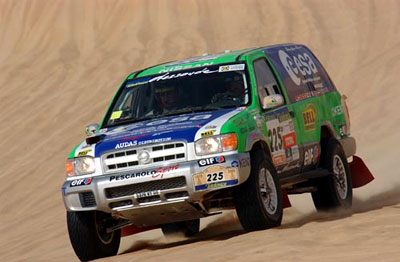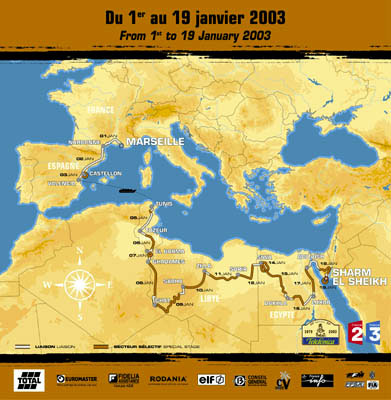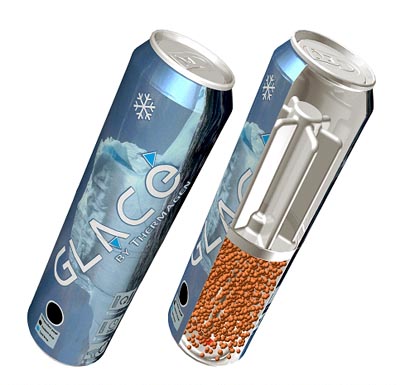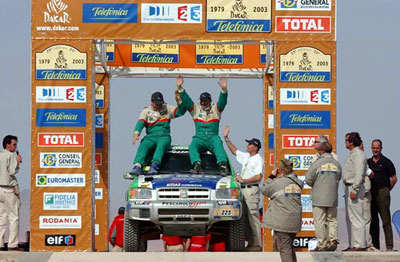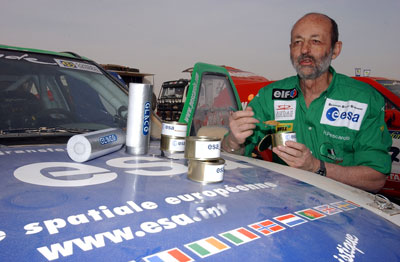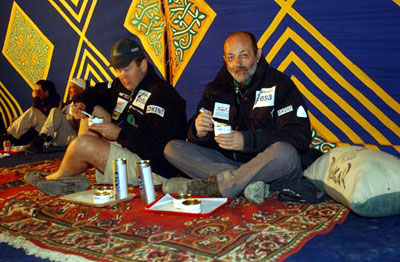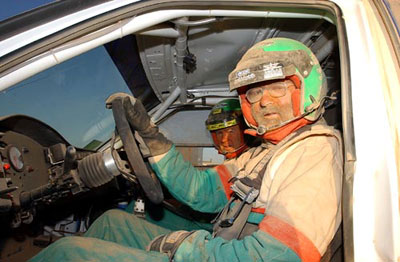Bringing the coldness of space to the Sahara
Cooling is key in the Sahara Desert, especially when you're in the middle of it, trying to win a race.
Cooling technology developed by ESA for space is helping one of the teams in this year's '2003 Dakar Rally', commonly known as the Paris-Dakar Rally.
The 25th series of this famous rally started 1 January from Marseille, France, when 342 contestants gunned their engines and commenced 19 days of the gruelling endurance race through France and Spain before entering the Sahara and racing across North Africa.
This year's route has been altered by an ugly geopolitical reality. Instead of finishing in Senegal's capital, Dakar, in West Africa, the cars, trucks and motorcycles will bypass the war-torn countries of Mali and Mauritania and travel east through Tunisia and Libya. They will cross the finish line on 19 January in Sharm El Sheikh in Egypt on the Red Sea coast after travelling 8 552 km. One of the teams in the race will be using ESA-developed space technologies to, literally, stay cool, in one of the hottest places on Earth where temperatures can reach as high as 58 degrees C. ESA is contributing several of its space cooling technologies to assist the Pescarola team, headed by racing veteran and four-time Le Mans champion Henri Pescarolo. Participating in his 14th Paris-Dakar rally, Pescarolo is driving a modified 255-HP, V6 Nissan Terrano bearing the ESA logo. He and his team will even eat like astronauts.
"We have pulled together several technologies, which will help the Pescarolo team during the Paris-Dakar race this year," says Pierre Brisson, Head of ESA's Technology Transfer and Promotion Office.
If all works as planned, the team will feel some of the coldness of space during their time in the desert.
Exhaust cooling from Ariane
A special thermal screen using technology developed for the European launch vehicle Ariane provides highly advanced protection and thermal insulation on the Pescarolo car.
The thermal screen is fixed below the car around the exhaust manifold. It reduces the temperature of the exhaust pipe to 100 degrees C, which otherwise would reach 800 degrees C. Thanks to the thermal screen, the team enjoys a significant safety boost with the decreased risk of fire in case of oil or gasoline leaks. In addition, the temperature inside the car is decreased significantly, adding to the drivers' comfort and lessening their fatigue.
Drivers' helmets with innovative cooling system
An Italian company, Grado Zero Espace from Sovigliana, near Florence, is providing a cooling system for the drivers' helmets which incorporates several ESA space technologies.
The cooling system uses solid-state Peltier elements to 'pump' the heat out from the inner side of the helmet and a circulating fluid system to transport the heat away to a special heat 'sink', where the heat is absorbed. The millimetre-thin, solid-state Peltier elements use electricity to produce the cooling effect without any moving parts.
The system combines two space technologies already applied in non-space applications. The Spanish company NTE (Nuevas Tecnologias Espaciales) from Lliçà d'Amunt, near Barcelona, has adapted the Peltier elements in thermal-regulated clothing. A Canadian space firm, Med-Eng in Ottawa, has produced the cooling circuit for a special suit developed by Grado Zero Espace for the McLaren Formula 1 team.
Mediaeval cooling boosted by space calculations
Drinks are being served in a completely new type of self-cooling container that may revolutionize the world of beverages over the coming years.
Used for centuries, the principle of using evaporated water to cool the contents of terracotta jugs and goatskins, is being applied by a French company, ThermaGen, which has developed a self-cooling container that lowers any beverage by 15 degrees C within minutes. It works by evaporating one centilitre of water using the cooling properties of the terracotta clay. The performance has been boosted for this race to over 20 degrees C cooling to meet the extreme desert conditions.
Where does space fit into this? The use of special advanced numerical simulation techniques developed for ESA for satellite mission calculations made it possible for ThermaGen to calculate precisely the behaviour of the complex physical phenomena that creates the cooling effect and to design the self-cooling container.
The rally will be the first test in a series before this innovation is ready for general use by sportsmen and people travelling in hot and isolated areas.
Space food for the crew
Originally developed for the French-Russian Cassiopeia mission in 1996, special space menus have enabled Russian European and American astronauts to savour southern French cuisine, far from their native tables.
The 'space food' has to pass extremely severe qualifying tests to be authorised as astronauts' food, including bacteriological quality control and flight-certified packaging. Lycée Hôtelier de Souillac, a leading French culinary institute located outside Toulouse developed, in partnership with the French space agency (CNES), a special space menu that fulfils all the stringent requirements for space, yet maintains the famous French gourmet standard. This 'haute cuisine' is highly appreciated by space consumers, and greatly contributes to the morale and good mood on the International Space Station. Catering with these menus for the 2003 Dakar Rally proves that it is possible to enjoy good food even in the harshest of conditions.
Space technology improving daily life on Earth
The European space industry has built up an impressive portfolio of technologies and know-how. Since 1991, ESA's Technology Transfer Programme has promoted the use of these technologies outside space systems. This has provided many innovative solutions for non-space products and services that today improve our daily lives.
"Our programme validates the technology developed in the European space programmes. More than 150 ESA space technologies are today improving life on Earth. In addition the use of these space technologies in non-space areas opens new markets, increases the competitiveness of European business and is a new sources of income," emphasizes Brisson.
There is work to be done before the advanced space technologies find their way to non-space systems on Earth. They must be evaluated, adapted for a specific use on Earth, and tested for duration and performance.
Testing systems incorporating these new technologies in extreme races like Paris-Dakar and Le Mans has always been a good way to verify if a new system is valuable in everyday automobiles.
"If a space technology proves its worth in these tough races, it has a future in everyone's car," Brisson added.
2003 Dakar Rally' completed
Henri Pescarolo with co-driver Serge de Liedekerke finished 28th in this year's '2003 Dakar Rally'.
"The car had good potential. Too bad we did not make it in the first 10 - my objective before the start," Pescarolo said after the race.
When car 225, a modified Nissan Terrano, worked well, it was just behind the leaders of the rally. However, "several technical difficulties made us lose too much time," Pescarolo noted.
"It was a beautiful race. Now we have to prepare for the future," he added.
Exhaust cooling from Ariane
A special thermal screen using technology developed for the European launch vehicle Ariane provided highly advanced protection and thermal insulation on the Pescarolo car.
Drivers' helmets with innovative cooling system
An Italian company, Grado Zero Espace from Sovigliana, near Florence, provided a cooling system for the drivers' helmets incorporating several ESA space technologies.
Cooling drinks for the drivers
Advanced numerical simulation techniques developed by ESA for satellite mission calculations made it possible for ThermaGen, a French company, to calculate precisely the cooling behaviour of terracotta clay to design a self-cooling container. The Pescarolo team tried out these innovative containers during the rally.
On the day of rest, 13 January, the Pescarolo team, car no. 225, had a special treat in Siwa, Egypt:
Extraterrestrial gastronomy
The setting was simple, a bivouac in the desert, but the food was 'real' space food, the same as astronauts enjoy on board the International Space Station. The menu included 'squid, duck confit with capers, pasta and rice cake with caramel sauce'. Very delicious, was Henri Pescarolo's comment.
16 January 2003 - Stage 14 from Dakhla to Luxor in Egypt
The setting of stage 14 is a forgotten track that was used by the camel caravans to go to Sudan. The stage's 702 km brings the competitors through mountains and finishes with a very steep descent. The rally then goes back into time at the archeological site of Karnak, the valley of Kings, the valley of Queens and quite a number of temples including that of Ramses II and the Pharaoh Queen Hatchepsout, the only woman to have governed ancient Egypt.
The day went well for the Pescarolo team. By ending on a 16th position, he advanced in the overall qualification to no. 21.
15 January 2003 - Stage 13 from Siwa to Dakhla in Egypt
Stage 13 is really a place where no-one wants to go. Initially the route goes though the 'cathedral dunes, which are over 100 m high and with each time steep descents. The second part of the stage goes across the 'white desert' starting from the Farafra oasis, where the wind also plays an important role.
Pescarolo finished the stage in position no. 16, and thereby maintaining his overall position as no. 22.
Note for editors: The 'space menu' served at Siwa, Egypt included:
Calmars à l'américaine: Coulis de langoustines, tomates concassées, vin blanc, Porto, Cognac
Confit de canard aux câpres: confit, fond de veau, fond de volaille, câpres
Pâtes au fromage: coquillettes, rapé, bechamel avec moitié lait, moitié bouillon de volaille
Riz au caramel: lait, vanille, sucre, riz Piémontais, caramel non décuit
